Software updates and patches are of critical importance because they can protect your systems and applications from vulnerability to malware, bugs, and other major issues. If you often ignore or postpone recommended patches, you can put your systems at risk. But ensuring all systems have been patched adequately can be challenging and time-consuming—if you don’t have the right patch management software in place.
By leveraging the best patch management software this year has to offer, you can ensure every network device is updated and secure. Software patch management solutions enable you and your team to deploy patches efficiently and quickly, as well as check devices and systems to detect their strengths and weaknesses. For enterprise-grade patch deployment, we recommend SolarWinds® Patch Manager. I believe this is one of the best patch management tools available on the market, offering an impressive library of pre-tested patches and can be automatically applied. I also found the 30-day free trial available for download is very helpful in determining whether this tool can fit your patching needs.
This patch management software comparison will also review alternative tools to help you choose the patch management solution best suited to your business’s individual requirements. After the patch management software comparison, I also provide a brief explanation of what a software patch is, what patch management is, and why it’s important.
Best Patch Management Software 2022
The market for IT software is becoming increasingly saturated, which can make choosing the right tool for your business’ needs challenging. To help you decide which patch management software is best for you, I compiled a comprehensive patch management software comparison review, which compares the best tools available in 2022.
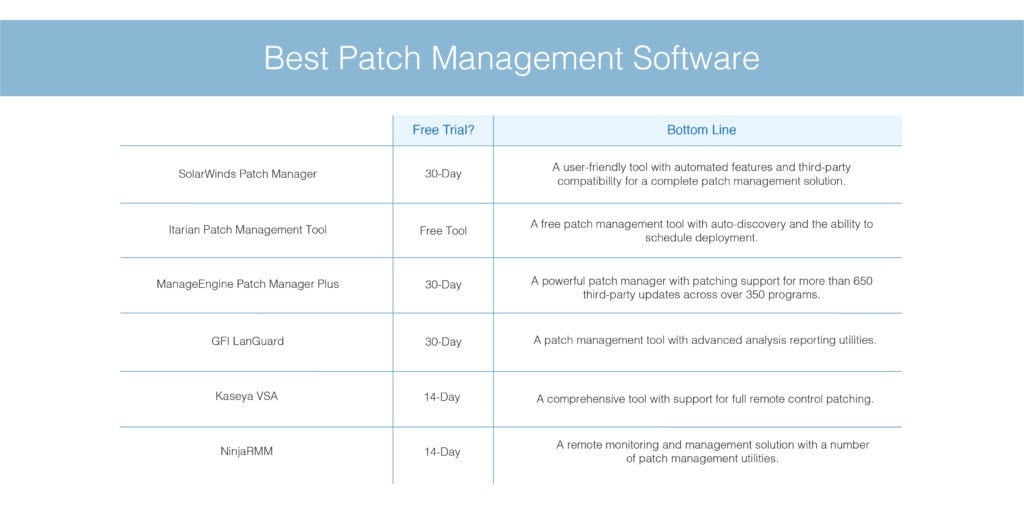
1. SolarWinds Patch Manager
SolarWinds Patch Manager is a comprehensive, enterprise-grade patch management solution, purpose-built to help you address software vulnerabilities quickly and with minimal intervention. This tool offers several impressive features, including integration with WSUS, as well as the Microsoft update agent, enabling you to automatically perform Windows updates according to custom schedules. You can even establish multiple patching schedules to reflect the needs of different business groups within your company, and their custom requirements.
This solution can be leveraged to streamline third-party software patch management activities. With Patch Manager, you can create before-and-after deployment package scenarios, to help ensure complex third-party applications patches are deployed without complex scripts.
Another benefit of SolarWinds Patch Manager I liked is its impressive reporting engine, which allows you to create customized reports. These reports deliver a detailed view of existing application weaknesses and patch statuses. Reports can address more than 500 fields of data, with over 100 definitions. When searching reports, you can filter, sort, and group them by patch status, WSUS target group, and application type. Patch Manager reporting capabilities can assist with compliance, because they enable you to easily demonstrate patch compliance to auditors.
Since Patch Manager is designed to monitor for failed patches or missing patches, it functions partially as infrastructure and network monitoring software capable of conducting vulnerability assessment activities. This tool comes with Package Boot technology, which helps ensure there aren’t any failed patches in your system. The Package Boot utility accounts for patches not deployed correctly, which can happen occasionally.
I believe SolarWinds Patch Manager is a versatile, user-friendly, scalable tool and the ideal choice for small and large businesses alike. With Microsoft WSUS patch management, SCCM integrations, support for third-party application patching, an intuitive patch status dashboard, and a computer’s inventory system, this solution can provide businesses with everything they might need to establish a robust patch management strategy. A 30-day free trial is available for download.
2. ITarian Patch Management Tool
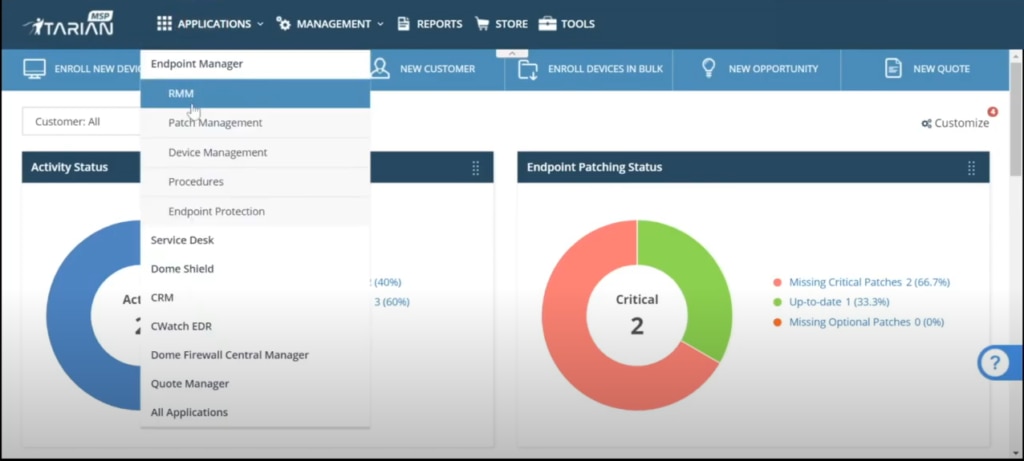
If you have your heart set on a free patch management tool, I believe the ITarian patch management solution is a good option. ITarian delivers a completely free platform for remote management and monitoring activities, offering remote control, auto-discovery, auto-deployment, customizable scripts, service desk, and patch management.
With this tool, you can quickly identify endpoints with vulnerabilities, as well as which endpoints require patching. When a vulnerability is identified, ITarian enables you to establish policies for automatically deploying updates to either a single endpoint or a group of endpoints. You can also schedule the process for a suitable time.
ITarian provides dashboard metrics and reporting capabilities, giving you a general view of available updates. You can deploy updates to both Linux and Windows operating systems. In my opinion, ITarian key patch management features include robust patch sourcing, auto-discovery of your system and managed endpoints, the ability to schedule and prioritize patch deployment, as well as comprehensive health and status reports.
As a free tool, I think ITarian patch management solution might not be suitable for business use. It’s not as well-supported as many of its paid competitors and can’t provide the same range of features or the same level of security. You can download ITarian for free by clicking here.
3. ManageEngine Patch Manager Plus
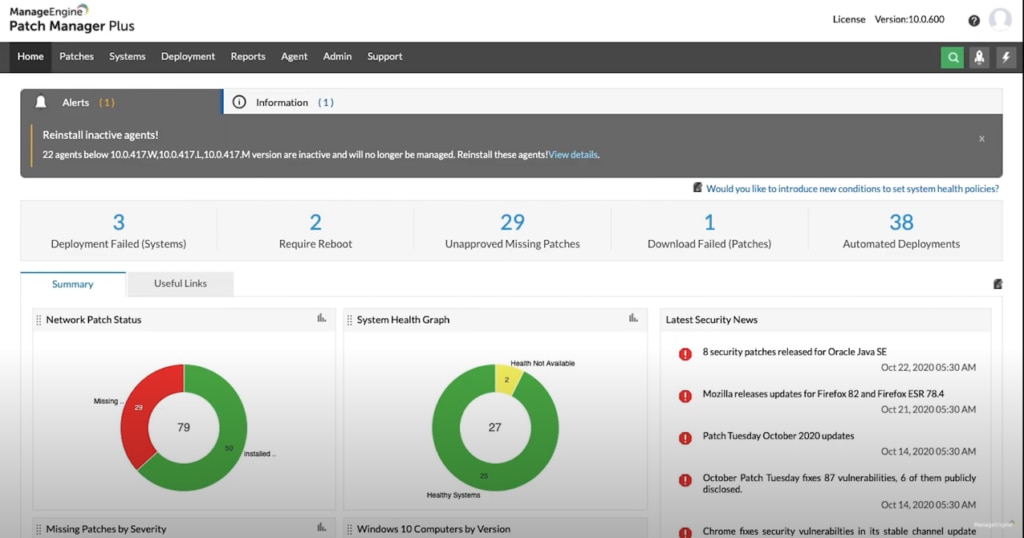
ManageEngine Patch Manager Plus, a company that may be more commonly known for its network monitoring software, also offers a patch management tool called Patch Manager Plus. I found this easy-to-use platform can help users keep their Mac, Windows, and Linux systems up to date as an all-in-one patch management solution, available both on the cloud and on-premises, providing automatic patch deployment, and patching support for more than 650 third-party updates across over 350 third-party programs.
I believe ManageEngine Patch Manager Plus offers an impressive array of features, including patch compliance, the ability to approve or decline recommended patches according to priority and severity, real-time reports and audits, support for implementing computer test groups, and much more. With the ManageEngine Patch Manager Plus tool, I found you can leverage tested, pre-built packages ready to deploy, making this a highly user-friendly tool requiring minimal time investment.
You can choose between a 30-day free trial of the on-premises edition or cloud edition by clicking here.
4. GFI LanGuard
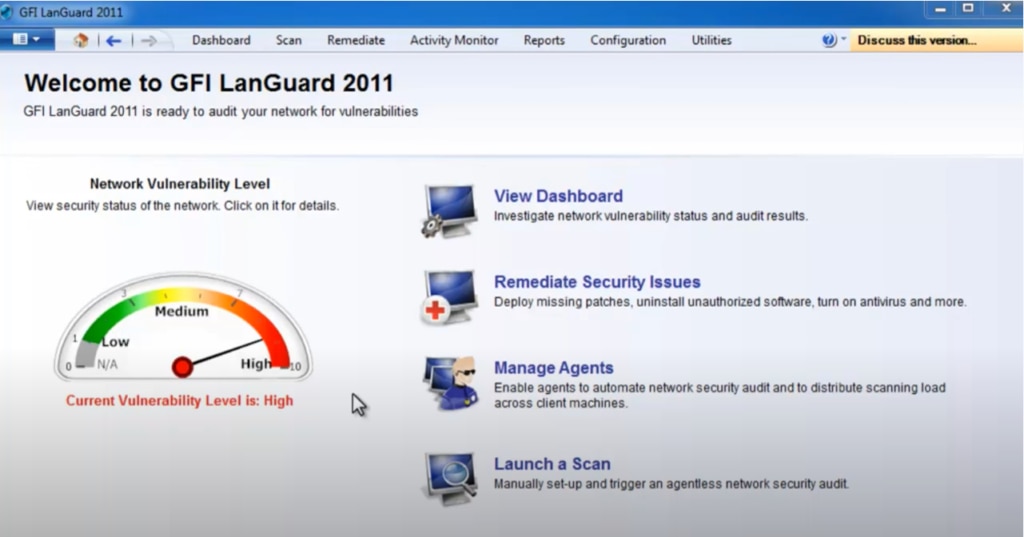
GFI LanGuard offers a patch management solution I found to be especially popular among SMBs. This tool supports most major operating systems, including Mac, Linux, and Microsoft, as well as over 60 third-party programs. I believe a notable benefit of GFI LanGuard is it features a clean and simple user interface, which is easy to navigate and interpret.
With this tool, you can conduct vulnerability assessments to identify threats and risks proactively, often before they affect your systems. GFI LanGuard automated remediation feature means as soon as these risks are identified, they can be mitigated. To keep you informed, GFI LanGuard features a built-in alerting system.
GFI LanGuard also includes advanced analysis reporting utilities, enabling users to generate reports providing extensive information. This includes details of installed applications, open firewall ports, file shares, antivirus status, as well as application specifics like default configurations.
This patch management solution also benefits from a change management utility, asset inventory features, and an intuitive mobile application. Although these aren’t necessary components of a patch management solution, I think they provide added value. A 30-day free trial of GFI LanGuard is available for download.
5. Kaseya VSA
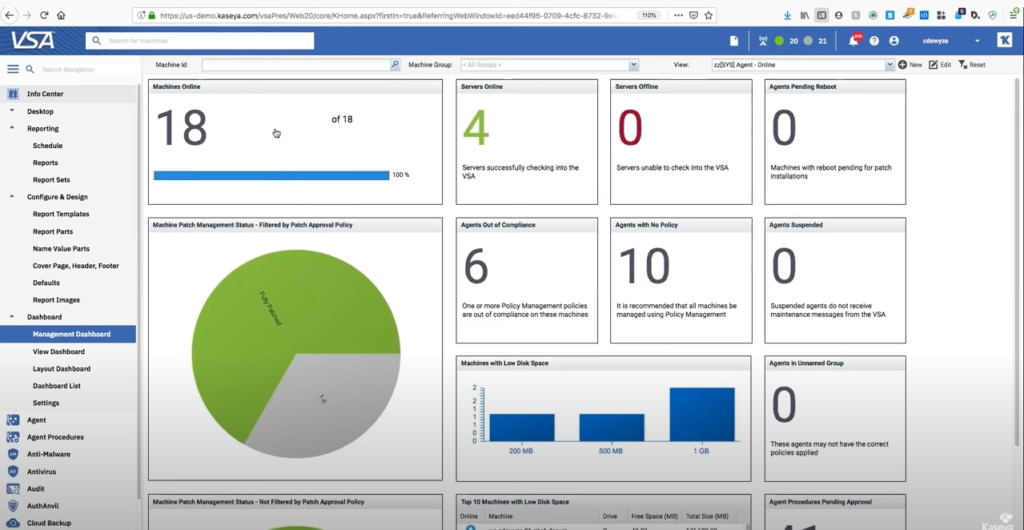
As an IT monitoring and management tool, I think Kaseya VSA provides a less specialist approach to patch management. This cloud-based tool was designed specifically for IT enterprises and managed service providers, with IT capabilities including patching activities.
Kaseya VSA provides a software management module, which enables centralized management, full visibility, and automatic deployment for updates across Mac, Windows, and third-party applications. With Kaseya policy profiles utility, you can automate application maintenance activities across platforms, and conduct patch deployment on devices either off or on the network. I believe this tool can enable fast software distribution, which is made possible by Kaseya Agent Endpoint Fabric. The Agent Endpoint Fabric optimizes installer delivery, even on high-latency networks.
Other notable Kaseya VSA features I found include complete protection from weaknesses, support for full remote control, the ability to schedule analysis and scans, migration from the VSA patch management module, the ability to override profiles, and much more. You can request a 14-day free trial of Kaseya VSA by clicking here and entering your details.
6. NinjaRMM
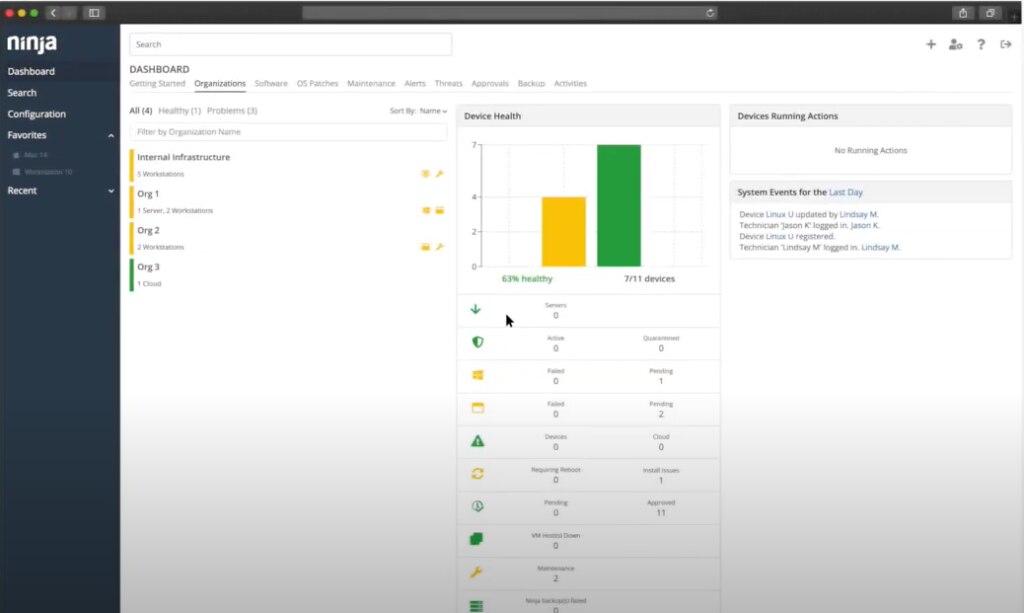
NinjaRMM is a well-known SaaS remote monitoring and management solution featuring powerful patch management utilities to help you plan, operate, and deliver corporate IT services, allowing you to manage network endpoints and devices. NinjaRMM also supports remote access, can perform antivirus scans, automates update deployment, and more.
With this solution, you can ensure your endpoint software is secure and up to date, with its easy-to-use patching features. NinjaRMM includes out-of-the-box configurations, enabling you to start patching as soon as you have launched the tool. This solution can automate patching for more than 120 third-party applications, and across Windows and Mac platforms.
I believe a key benefit of NinjaRMM is it allows you to customize updates and scans for machines, whether for a group of devices or a single device. You can also quickly approve or reject patches via the NinjaRMM automated patch management feature. NinjaRMM provides granular control options for patch schedules, overrides, approvals, and reboot. You can even download patches directly to each machine or use a WSUS server to minimize bandwidth utilization.
Although versatile, I think Ninja remote monitoring and management could be more user-friendly. You can download a free trial of NinjaRMM here.
What Is a Software Patch?
Software patches are simply lines of code created to update and change existing program code, to resolve potential security weaknesses and other issues. Once designed, then tested, patches can be applied either by an automated tool—such as patch management software—or manually by an administrator. There are different types of patches, such as security patches, unofficial patches, hotfixes, and service packs.
What Is Patch Management?
Now that you have an understanding of what software patches are, you might be wondering what patch management entails. In most cases, vendors will release patches and you’ll be alerted when a software update has become available. This is something businesses and individuals alike may find familiar. The process of patching one software solution from a single vendor should be reasonably straightforward, but it’s significantly more complicated if you use multiple devices, each with various applications and vendors.
If you want to ensure patches are applied to your devices simultaneously, you will need to implement a robust and organized patch management strategy and schedule, in addition to implementing a suitable patch management tool. This is especially important if your environment uses a mixture of cloud-based, virtual, and physical components. In a hybrid environment of this nature, a patch management tool can help you streamline updates to ensure your infrastructure is fully secure. Patch management tools can assist with applying patches across the complete system, concurrently, as an alternative to manually applying each patch to every single application individually.
The Importance of Patch Management
Although patch management might not seem to be of critical importance, it can be among the most essential contributors to the security and productivity of your complete system. Updating and patching are important for many reasons, which is why companies should leverage automated tools to help them perform these activities.
First and foremost, patching is crucial because it ensures business software is performing and functioning as it should be. In some cases, outdated software becomes prone to slow performance, crashes, and may not function at all. To fix issues with outdated software, you need to keep it updated. The more time passes without the appropriate update being applied, the worse these issues will become.
Another reason patch management is important is software updates often come with new features to extend your software’s capabilities. By patching and updating software, these features will be added, ensuring your business is making the most of its investment and keeping up with the most recent technological innovations. This is especially important in an enterprise environment, where keeping up with competitors is essential.
The most important reason for managing updates and patches is security. Outdated, unpatched software can create significant weaknesses in your systems, which may allow cyberattackers to gain access to your systems. While these vulnerabilities may initially only expose individual systems, this can quickly impact your wider network and data. Because of this, infrastructure and network security patches are paramount. In fact, a key function of most software patches is fixing problems, such as bugs that might cause security weaknesses.
The ability to apply a patch quickly and efficiently mitigates a cyberhacker’s window of opportunity to launch an attack, reducing the likelihood of your systems being successfully infiltrated. In short, patches play a critical role in maintaining high levels of security and are also key to maintaining compliance in many cases.
To ensure effective patch management, businesses should use a patch management tool. This is because manual patch management is time-consuming, labor-intensive, and error-prone—and if even one machine or program goes unpatched, this can leave your system vulnerable to cyberattack and compromise network security. An automated patch tool helps you avoid missing patches, keeping your infrastructure safe and secure.
Choosing the Right Patch Management Software
Of the patch management tools listed in this guide, SolarWinds Patch Manager ranks highest, because it delivers the most user-friendly and comprehensive solution. Choosing a patch management tool suited to your business needs can be challenging, which is why we recommend making the most of the free trials linked throughout this guide. For a 30-day free trial of SolarWinds Patch Manager, click here.
*As of November 19, 2020